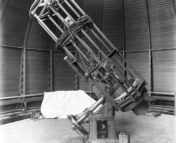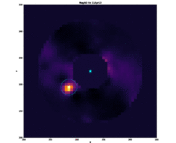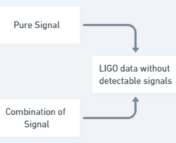The Undergraduate Research series is where we feature the research that you’re doing. If you are an undergraduate that took part in an REU or similar astro research project and would like to share this on Astrobites, please check out our submission page for more details. We would also love to hear about your more general research experience!

Mariah Jones
Vassar College
Currently in her third year at Vassar College, Mariah Jones is on track to receive her B.S. in physics and astronomy, with a French concentration, in May 2025. Mariah has always had a passion for astrophysics, joining her first research group as a senior in high school with Brett Andrews, professor of astrophysics, at the University of Pittsburgh. Since then, Mariah has participated in a number of projects, and is currently working with her major advisor on simulating magneto-hydrodynamically turbulent material in the circumgalactic medium. This post describes findings from her 2023 summer project conducted at the University of Chicago under Paul Chichura, Tom Crawford, and John Carlstrom.
Introduction
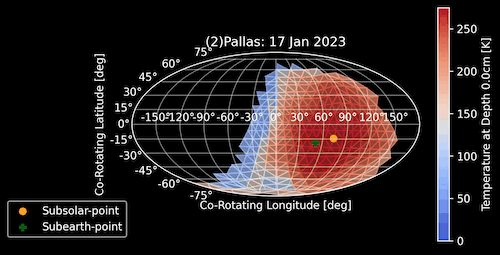
The South Pole Telescope (SPT) is a 10-meter telescope operating in the millimeter and submillimeter regime. Located at the pole due to its high elevation and dry climate, the telescope is designed to measure the polarization of the cosmic microwave background (CMB), light left over from the early universe. In order to take high quality measurements of CMB polarization, the SPT needs to focus on specific patches of the sky for extended periods of time. Within these long exposures, other objects like asteroids can enter the telescope’s field of view. While these asteroid photo-bombs can be a nuisance for cosmologists observing the CMB, these microwave-band observations of asteroids provide a unique opportunity for a different kind of astrophysics research. Currently, most asteroids are observed in optical and thermal (IR) wavelengths, but studying an asteroid in microwave regimes provides scientists with an opportunity to peer deeper into the surface of the structure due to having longer wavelengths. The physical properties of asteroids can tell us a lot about the evolution of the universe and planets, which is why using longer wavelengths is beneficial to our pursuit of knowledge about our cosmic origins.
Methods
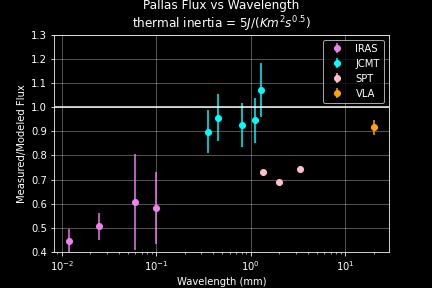
to modeled flux measurements with
respect to wavelength of the asteroid (2) Pallas with a thermal inertia value of 5. Data points are from IRAS, JCMT, SPT, and VLA. Credit: Mariah Jones.
The goal of my project was to determine whether or not SPT data is useful in constraining a particular thermophysical property of asteroids known as thermal inertia. In order to do so, I first needed to understand how temperature is distributed as depth into an asteroid increases. Though we aimed to make this model applicable to a range of asteroids, I focused specifically on (2) Pallas. I wrote an interface, with the help of my mentor Paul Chichura, capable of loading in an asteroid shape model, rotating the asteroid n steps and updating the temperature of a facet, or specific point on the asteroid. With each rotation, the time required for the simulation to equilibrate temperatures decreases; by writing a fitting function that turns the last guess of the previous run into the new initial temperature guess, I was able to significantly optimize the runtime, expediting the process of equilibrium.
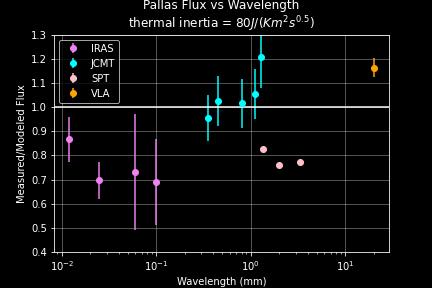
to modeled flux measurements with respect to wavelength of the asteroid (2) Pallas with a thermal inertia value of 80. Data points are from IRAS, JCMT, SPT, and VLA. Credit: Mariah Jones.
Temperature is an important property of an asteroid, as it allows scientists to better understand their composition and formation processes. Being directly proportional to flux, the hotter something is the higher the flux. This specific identity allowed me to check the accuracy of my model, which involved writing a function capable of calculating flux values based on simulated temperatures, and then comparing these output values to observed flux data from three additional telescopes in a range of frequencies: VLA, JCMT, and IRAS. Selected SPT measurements were observed at the three frequencies in which the telescope operates– roughly 90, 150, and 220 GHz. I was lastly able to plot the ratio of measured data to modeled outputs with respect to wavelength, allowing me to assess which telescope yielded the most beneficial results.
Results
Figures 2 and 3 demonstrate the ratios of measured data points from four telescopes to the simulated outputs of flux measurements. The difference between the two figures is the value of the thermal inertia; when set to 5, the ratios are a lot farther from the y=1 reference line compared to when thermal inertia is equal to 80, leading to the conclusion that (2) Pallas probably has a higher thermal inertia value.
An important thing to note are the error bars of the data points, specifically those of SPT; IRAS, JCMT, and VLA data has noticeably larger error bars than SPT, which looks like it virtually has none. This is not the case, of course– the data is just highly precise. This high precision is due to the telescope’s unique detection method, allowing for long exposure times of asteroids. The minimal uncertainty of the telescope’s measurements is the reason why we were able to conclude that SPT data is extremely useful in constraining thermophysical properties. Compared to the other three telescopes, the data observed by SPT is significantly more reliable because of its low uncertainty, and therefore a credible reference when checking the accuracy of the simulation.
Conclusions
Based on the resulting ratios of observed flux measurements to simulated flux outputs, I was able to answer my research question and conclude that SPT data points are very reliable in determining thermmophysical properties of asteroids. The ending simulation was able to realistically model the temperature distribution of Pallas with respect to depth, and because of this realistic model, we were also able to infer that this asteroid has a higher thermal inertial value; we selected values covering a wide range of numbers, and noted that the ratio was closer to 1 for the highest selected value. Overall, this summer was very successful: in this short time frame, I was able to produce code which generated flux outputs of an asteroid which were within an accuracy of 20%, a promising accomplishment when considering what could have been done if more time were available. The next steps of this project, if it were to have progressed, would entail optimizing our fitting function and incorporating more complexity into the model to account for more granular surface features such as craters and varying surface materials. I am very pleased with the end result of this project and the many things I was able to accomplish under the guidance of my advisors.
Astrobite edited by: Lucas Brown
Featured Image Credit: UCLA, B. E. Schmidt And S. C. Radcliffe.

